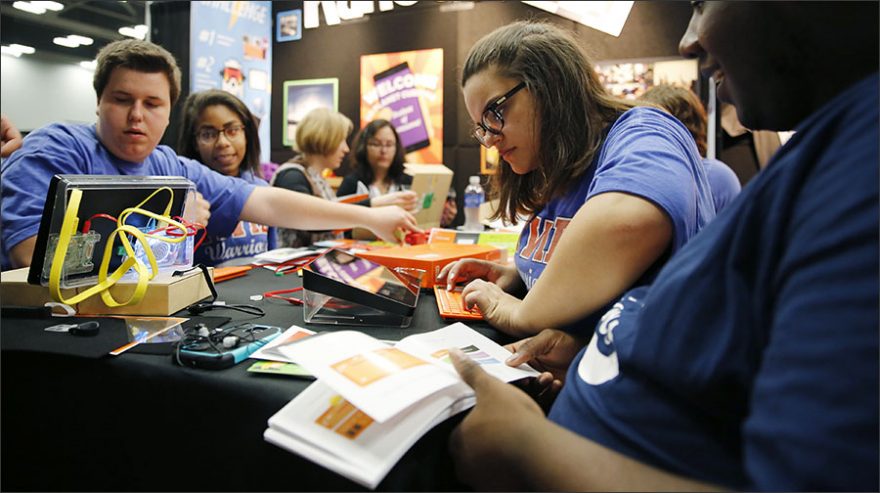Competing Pressures Squeeze, Shake K-12 Assessment Landscape

Austin, Texas
The testing world is being gripped by two overriding, and often competing forces: the continued reliance on big, high-stakes assessments for accountability purposes, and the rise of more sophisticated, nimble, and smaller-scale digital assessments, largely at the classroom level.
Those two types of assessments are in some ways moving on separate tracks, explained a group of panelists who brought a deep collective experience researching and developing exams to a panel at the SXSWedu conference this week.
On the one hand, the demand for big, summative assessments is being pushed along by policymakers and a collective belief—not an unreasonable one—that the public benefits from the big-picture data on student performance those exams produce, the panelists suggested.
But the pressure to create and use those summative tests also comes from other, rather obvious forces, explained panelist James Pellegrino of the Learning Sciences Research Institute. For one thing, there are billions of dollars at stake in the testing industry, he noted. (And states have spent heavily staging high-stakes exams.)
But there’s also a brutal simplicity to the test scores that state exams spit out that has become the accepted norm in discussions about education today, he noted. Those scores are the basis for rating districts, schools, and in some cases, teacher performance, Pellegrino said.
“People want a number,” he said, adding that “America leads the way in this kind of assessment. It has become a part of [our] DNA.”
Pellegrino and others on the panel were asked by moderator Randy Bennett of the Educational Testing Service to speculate on what aspects of the K-12 assessment world are likely to change, or not change, in the next few years. Some of the panelists’ observations will seem familiar to testing-industry insiders, but they were probably enlightening to the ed-tech community gathered at SXSWedu.
The reliance on high-stakes tests isn’t likely to fade from view anytime soon, the panelists seem to agree—pressure from the “opt-out” movement and other quarters notwithstanding.
That’s partly for the reasons Pellegrino laid out. It’s also because of government policy, notably mandates like the new Every Student Succeeds Act, which gives states new flexibility on testing but ultimately isn’t a major departure from the core requirements of No Child Left Behind, Bennett said.
One of the fundamental challenges with large-scale assessments is to make them trustworthy and innovative—and to do it at scale, said Eva Baker, the co-director of the National Center for Research on Evaluation, Standards, and Student Testing at UCLA.
“Putting those three things together makes the problem very hard,” Baker said.
The pressure is to keep those summative tests “short and cheap,” Baker said. That pressure partly explains an aversion to risk-taking and innovation on those tests.
Moving Toward a Useful Test?
On the flip side, some of the most promising advances in assessment are coming largely away from the high-stakes testing arena, as cognitive science and digital advances allow for classroom assessments that are more diagnostic and useful, the panelists said.
In the future, “assessment will be personalized to the interests, and perhaps, skill levels of the students,” Bennett said.
Increasingly, assessment is producing insights on students’ skills and well-being in different areas, such as digital problem-solving and social-emotional health, he said. Assessments embedded within games also hold the potential to produce a better understanding of student learning.
Many of the exciting innovations in testing today are playing out “where the teaching and learning occurs,” Pellegrino said, in formative assessment and similar classroom-based approaches.
The potential is to move from an “audit mode to [an] assistance mode of assessment,” he added, with schools using data to help improve student learning.
One of the fundamental tensions noted by the panelists is that the public and policymakers want shorter, cheaper tests—but ultimately, those kinds of tests generally produce information that’s less useful, in terms of informing teaching and learning.
Given those constraints, I asked Pellegrino whether it was possible to recast the landscape to combine elements of both high-stakes and classroom assessment models. He suggested that policymakers should try to create coherent “systems of assessment” from the state to the classroom level, with different tests that capture data for many purposes—public accountability, and student learning.
Photo: Students from Westwood High School in Round Rock, Texas build a computer at the Kahoot booth on Tuesday at SXSWedu in Austin, Texas. ––Erich Schlegel for Education Week
See also:
- Understanding Formative Assessment: A Special Report
- As McGraw-Hill Education Leaves State Testing, Market Thrives for Classroom Assessment
- Common-Core Testing Contracts Favor Big Vendors
Follow @EdWeekSCavanagh and @EdMarketBrief for the latest news on industry and innovation in education.
